

Pharaoh Zoser was the first king of the Third Dynasty. The serdab, on the northern face of the pyramid, contained his statue; this was the place of his "ka," which could see the offerings made to him. The original statue, now in the Cairo Museum, is thought to have recorded his exact features. This pyramid and the buildings comprising the funerary complex were designed by Imhotep, the first architect whose name is recorded. They were also the first major constructions in stone. Prior to this, sun-dried brick had been the usual building material. It is also the first tomb of monumental size. It was begun as a large mastaba, oriented to the points of the compass, but was enlarged twice to a final height of about 200 feet.The Stepped Pyramid from the Great South Court | ||
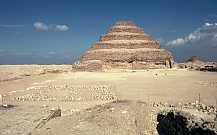
|
The stepped pyramid is midway between the earlier mastaba tombs and the perfected forms at Giza. It seems to be composed of a series of mastabas, each smaller, and stacked on top of each other. It was built of fairly small limestone blocks, much smaller than those used later at Giza. (See detail of pyramid wall.) It was sheathed in fine limestone from the same quarry used for the stone of the Giza pyramids. | |
The pyramid was situated in the center of a large enclosure (about 1800 by 900 feet), entirely surrounded by a paneled and bastioned wall of white limestone. The enclosure wall still survives in some places on the south side (though much shorter) and has been rebuilt on the east side to its original height of more than 30 feet.The enclosure wall | ||

|

|
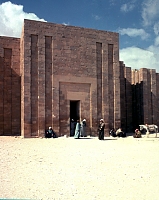 |
The southern tombIn the southwest corner of the court there is a sanctuary or storeroom, accessible from the outside of the enclosure wall. The wall is paneled and topped with a frieze of cobras (uraei), the symbol of the capital of the Delta kingdom before unification. |
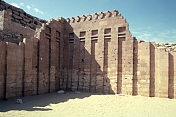 |
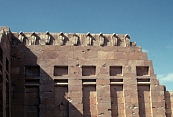 |
Most of the structures within the precinct were "dummy" buildings, with stone walls enclosing a fill of rubble. Stone had only been used for door frames so Imhotop found his precedents in organic forms: "bundles of reeds tied together in the corners of brick structures with heads fanning out. . . transcribed into stone, ...became the fasciculated column with capital; he simulated in stone the logs placed edgewise to form a roof; palm stalks, reed fences, matting, papyrus and other soft materials of which the contemporary houses were constructed, and which have all perished, thus became petrified in a medium that lent itself to stateliness and austerity" (83). Most of the main structures were in pairs, symbolic of the North and South, and indicating that rituals were probably repeated.House of the South with engaged proto-Doric columns and House of the North with engaged columns in the shape of the papyrus plant (even to the triangular shaft, imitating the stem) and right: columns of the "T" temple and one of the shrines around the Heb-Sed (Jubilee) Court | ||
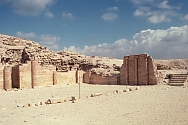
|
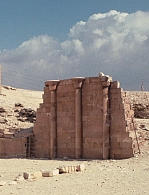
|

|
There is only one entrance to the complex, situated in the center of the largest bastion of the enclosure wall at the east. The narrow corridor was once roofed and dark. The colonnade is comprised of 40 fasciculated columns, ribbed in imitation of palm stems, with each connected to the side wall by masonry.The Entrance Corridor | ||
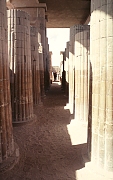
|

|

|
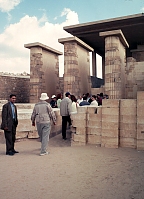
|
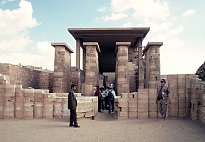
|
The Entrance Corridor from the Great South CourtAt the end of the colonnade there is a rectangular hall, supported by eight fluted columns (shorter than those of the colonnade). |
 Click here to go to the Egypt Index.
Click here to go to the Egypt Index.
 Click here to return to index of art historical sites.
Click here to return to index of art historical sites.
 Click here to return to index of artists and architects.
Click here to return to index of artists and architects.
 Click here to return to chronological index.
Click here to return to chronological index.
